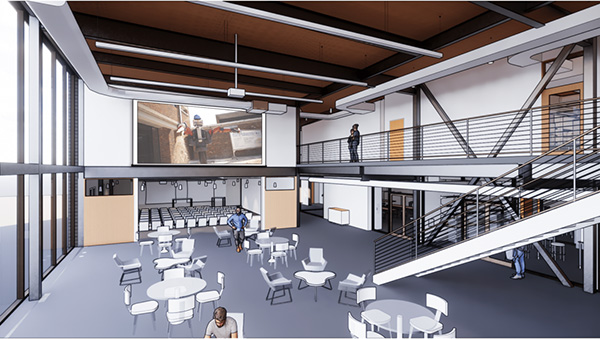What Do STEM Professors Really Think About the New Science and Engineering Building?
by Giana Pollock
Many of the students enrolled at Cape Cod Community College (4C’s) are aware, at this point, of the construction of the new Frank and Maureen Wilkens Science and Engineering Center building. The information on the build has been covered in the Main Sheet’s February 11th, 2020 edition, but what about insight on what the STEM professors and Dean think of this up-and-coming opportunity for the college? Professors Amy Clark (Science), Frederick Bsharah (Engineering), and Dean Donald Crampton have been interviewed to get an idea of the more individual ideas from people in the STEM department. Crampton and Bsharah agree that they are both very excited about the new building, and all three can agree that the new building will bring great opportunities to 4C’s.
“The new building will offer students the up-to-date materials, labs, and equipment they need to be successful in STEM fields,” Clark said.

Bsharah adds to the emphasis on the importance on the building being new, believing that it will improve 4C’s tremendously. “[It’s] a modern, state of the art building that is sorely needed by the college. This building will go a long way towards making STEM studies at 4C’s productive and more effective. The lab spaces will support student learning ways not possible in the current building,” said Bsharah.
Crampton even touches on the goals of the new building. “The building is designed to support a culture of curiosity, learning, and success in STEM, to encourage persistence and completion of STEM degrees, to attract industry collaboration, and to facilitate community partnerships in STEM education,” said Crampton.
Along with opportunities, the professors and Dean were asked if they are anticipating the new building to bring more STEM students and STEM success. All three of which easily agreeing that more students and success will be brought to the STEM department. Crampton explains that the new building isn’t only for the success of 4C’s, but for the whole community. “Middle and high school students will be able to gain experience in STEM and see first-hand the innovative opportunities at 4C’s,” said Crampton.
Clark adds to this, explaining that the new building will aid in 4C’s becoming a competitor to four-year colleges. Bsharah concludes to this that the new building is much needed for 4C’s to continue growing.
“Current faculty and students are sometimes fighting with obsolete equipment and barely in code facilities when they should be spending their time on teaching and learning,” said Bsharah.
Bsharah and Clark can both similarly agree that the current construction isn’t greatly affecting in-class labs during the fall semester. Most students are not on campus, which Bsharah notes as an advantage, because it will not distract them.
The faculty and students are required to take important precautions while being on campus because of the new build.
“The quality of the [lab] experience has not changed, just the density of students in the room,” said Clark. She, along with the students, knew that they would be facing obstacles, but that will not stop them from giving and receiving the same education during the construction.
Crampton lists some of the precautions that are in place because of the construction. These include construction occurring when there are less labs in session, sealing off the old Science building, shoring added for building stability, and constantly cleaning the lab equipment. With everyone participating with the many precautions, the construction and in-class labs will go smoothly.
With this being said, it was important to see if the professors really felt safe teaching during a major construction to the college, both of which saying they definitely do. One of the most important things to takeaway from the interview are the facilities promised, which the professors are most excited for in the new building. Clark shows that sometimes it’s the simple things that matter the most. “The science faculty are looking forward to better ventilation, lighting, storage, workspaces, and study areas for students,” said Clark. Bsharah shows with great excitement that the new laboratories for engineering is what he is looking forward to the most.
“The Robotics Lab will be the site for the best robotics and mechatronics education in SE Massachusetts. The laboratory will include collaborative, industrial, autonomous, and mobile logistics robotic systems all integrated together within an industry 4.0 smart factory backbone; making it a world class teaching center for both the student and workforce communities. Our Digital Manufacturing Lab will be equally impressive for teaching design for additive manufacturing (DfAM) as well as molding and milling technologies. We will have over a dozen 3D printers supporting fabrication in at least 15 types of materials ranging from environmentally safe plastics to high temperature carbon,” said Bsharah.
According to Crampton, the Payette, W.T. Rich Company, and the Massachusetts Department of Capital Asset Management and Maintenance (DCAMM) “have done a great job keeping construction on schedule,” so if you’re a part of the 4C’s community, expect to see the Frank and Maureen Wilkens Science and Engineering Center open in Spring 2023!
In the meantime, Bsharah said he will not be sleeping out of pure excitement for the new Science and Engineering building.
Categories: Around Campus, Featured, Professors